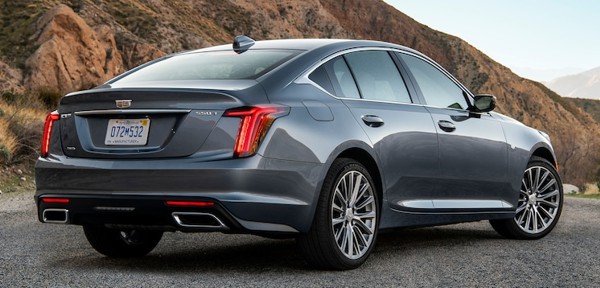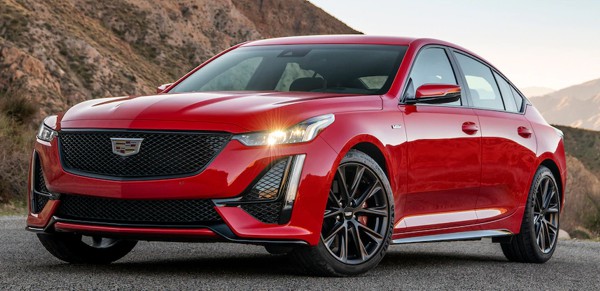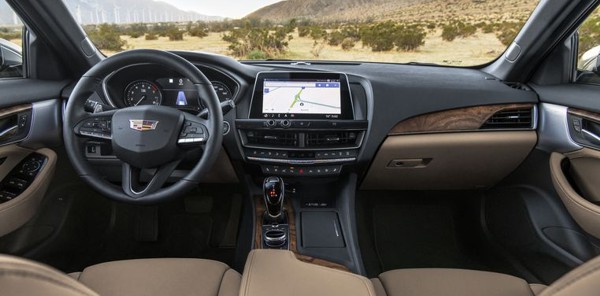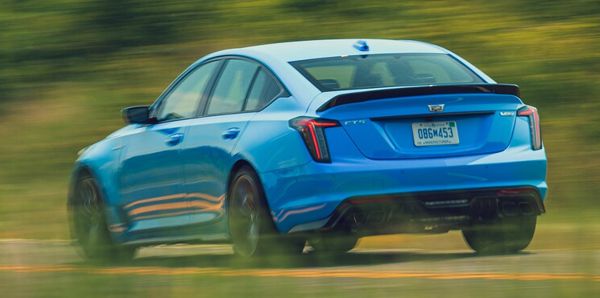Published
on 27
Feb 2020
|
All rights reserved.
|
|
|

|
|
CT5
is assumed to be smaller than the CTS, but in many ways it is not.
|
|
The market positioning of
Cadillac CTS has always been embarrassing. The first two generations
CTS targeted at BMW 3-Series, Mercedes C-class and Audi A4 etc. They
were considerably larger than their rivals, of course, but American
cars are always larger yet cheaper, so that was still understandable.
Somehow, in the third generation, Cadillac thought itself now premium
enough to abandon the “more metal for less money” strategy, so it made
the CTS just as large as the 5-Series and priced it at nearly the same
level. Predictably, it failed, and failed badly. US sales dropped from
the 60,000 units level in its hey days to only 10,000 units in the last
3 years, which is a joke when you see BMW shifted 350,000 units of the
5-Series globally a year. The bosses of Cadillac seriously
overestimated the brand value of Cadillac. Come on, after 50 years of
decline and neglect, Cadillac is no longer the jewel of the crown in
American motor industry. Not even American motorists see it a match for
European luxury brands. “Get down to earth and give me a realistic
proposal”, said the General.
Consequently, Cadillac has its product strategy overhauled. Now, the
baby ATS has its target shifted from the 3-Series to the smaller
Mercedes A-class sedan and Audi A3 sedan (as well as the upcoming
2-Series Gran Coupe). It is renamed CT4 to avoid embarrassment.
Meanwhile, the CTS nameplate is dropped, replaced by the new CT5, which
is marginally smaller but priced significantly lower to align with the
3-Series. The long-serving XTS is put to retirement, and unexpectedly,
the rather new and sophisticated CT6 finished its ultrashort tenure and
RIP. The sedan line-up of Cadillac has been “streamlined” to make space
for SUVs. No more ambition to revive Cadillac as a world-class luxury
brand.

|
|
The
deck seems to be cut short to fit the maximum length requirement.
|
|
Having learned this background, we have no much expectation for the
CT5. Theoretically, the CT5 shall be smaller than the last CTS.
However, save a 40 mm reduction of length, it is by no means smaller.
In fact, its width gains almost 50 mm, and its wheelbase is stretched
by 36 mm to boost rear legroom. On scale, the base CT5 is only 14 kg
lighter than its predecessor. Obviously, GM keeps much of its
underpinnings to save development costs.
The styling is very different though. From pictures, this car looks
hardly promising. While the front end has some character of its own,
the details look busier and less special than the last CTS. The side
profile is worse. Its proportion is so unbalanced! It employs a
fastback-like silhouette, which would have looked as sleek as an Audi
A7 if not the abruptly chopped deck. The latter seems to be cut short
just because the designers found they could not meet the maximum length
assigned by their big boss in the last minute! Worse still, the rear
quarter window is replaced by a black plastic panel, which looks mess
and cheap. Cadillac said its exterior design is inspired by the Escala
concept shown in 2016. It was a truly beautiful concept. Unfortunately,
the transformation to production is unsuccessful due to many
constraints. One more problem of the car: it looks big and heavy. It
might be a selling point to those preferring more metal for the same
money, but most motorists today want their cars to look agile and
sporty.
 |
|
The
2.0 Turbo engine lacks both power and character.
|
|
The car still rides on the Alpha platform, though now referred to Alpha
2. There seems to be no more use of lightweight materials or
construction, as Cadillac did not mention. The suspensions are just the
same, with MacPherson struts up front and multi-link setup at the back
just like the class norm. However, the Alpha cars (ATS, CTS and Camaro)
have always been known for great handling, thanks in part to perfect
balance and stiff structure, so we should have no complaints.
Unfortunately, when adapting the Alpha for use in CT5, Cadillac also
softened its suspension a bit in attempt to boost refinement. As a
result, the CT5 loses the tight body control and sharp turn-in of its
predecessor. It steers a bit slower, understeers and rolls a bit more.
The steering still communicates with the driver better than its German
opponents, but as a whole the handling loses the edge. It feels
heavier, less fluid and less precise in its response than a 3-Series.
The ability of power slide is sacrificed as well. To provoke it into
oversteer is almost impossible on the road, especially when the base
engine offers so little power.
Yes, that Ecotec 2.0 turbo four is underpowered. For reasons only GM
knows, its output is slashed by 35 hp and 38 lbft, dropping to 237 hp
and 258 lbft. That’s significantly less than a 330i (258 hp / 295
lbft), let alone Alfa Romeo Giulia (280 hp / 295 lbft). This means its
0-60 time trails its rivals by more than a second, a day-and-night
difference. Apart from slow, GM's four-cylinder engine is short of
character. It is not the most responsive at the low end, and it is
reluctant to spin beyond 6000 rpm.

|
|
CT5-V
loses 280 horsepower, but its chassis remains competent.
|
|
If you want more performance, you may opt for the 3.0-liter twin-turbo
V6 in 2 states of tune. On the CT5 Premium Luxury model, it produces
335 hp and 400 lbft of torque. On the CT5-V, it makes 360 hp and 405
lbft. Yes, CT5-V. I know the old CTS-V employed a supercharged
small-block V8 good for 640 horsepower and 630 pound-foot of torque. It
was the most fearsome rival to BMW M5 and AMG E63. But remember,
Cadillac has its strategy rationalized. The new V is actually the old
Vsport, or the equivalent of BMW M340i, AMG C43 or Audi S4. Forget the
glorious history of CTS-V and accept the reality! 360 horsepower
translate to 4.8 seconds in 0-60, not bad really, but slower than its
German rivals for sure. Even if the couple of tenths not matter to you,
you must care about the GM V6’s lack of noise – no wonder Cadillac
feeds you synthesized sound through the speakers. The V6 is a much
better motor than the four, of course, but it also lacks a free-revving
character that a world-class motor deserves.
The GM-Ford 10-speed automatic serving all CT5 models is decent in
general, but compared with the excellent ZF 8-speeder of its rivals,
you will find: a) 10 ratios are really too many for manual control; b)
The downshift is rather slow.
That said, the chassis of CT5-V holds up well with the aforementioned
rivals. Unlike the regular models, it adds magnetorheological adaptive
dampers, Michelin PS 4S tires, active LSD and GM’s very sophisticated
performance management system to the equation. Tighter body control and
sharper turn-in return. Coupling to the communicative steering and
superb brake feel, the CT5-V is engaging to drive, just losing out to
its rivals in the powertrain department. Meanwhile, the ride is firm
but not uncomfortable. The stiff body structure copes well with nasty
bumps, although high-speed refinement is compromised by more wind noise.
 |
|
If
you want to know how Cadillac managed to offer more metal for the same
money, even though at a smaller economy of scale, the interior is where
the answer is.
|
|
In the end, the CT5 is hard to recommend. Its fatal problem is not the
chassis, not even the underwhelming engine or performance, but once
again the interior. Space-wise, it is strong. Rear legroom is easily
more generous than its more compact rivals, although headroom is a bit
compromised by that sloping roof. The interior feels airier than CTS
thanks to larger windows. Styling-wise, the interior is a failure. It
looks conventional to the point of boring. But most disappointing is
the perception of quality and attention to details, which are both
lacking. While most materials aren’t cheap, they are mixed and matched
with cheaper plastics. There are too many different materials and
textures to deliver a coherent feel. The switchgears are cheap items
coming straight from GM’s parts pool. The front seats lack lateral
support. The CUE infotainment system is finally improved with quicker
response, simpler menus and additional hardware buttons, but still, it
is not quite as advanced or easy to use as those of its German rivals.
If you want to know how Cadillac managed to offer more metal for the
same money, even though at a smaller economy of scale, the interior is
where the answer is.
Overall speaking, the CT5 can be seen as a step backward from the last
CTS. Slower, less entertaining to drive, and not even as good to look.
By repositioning its market place, it might be more competitive.
However, when the very good Alfa Giulia, Genesis G70 and Jaguar XE fail
to get traction in a segment so dominated by the German Big Three, the
prospect of CT5 is no better than its predecessor. Good luck!
|
Verdict:    |
Published
on 11
Sep 2021
|
All rights reserved.
|
|
CT5-V Blackwing
|
|

|
|
The
best luxury sports sedan in the world?
|
|
It’s like a great
basketball player entering the last game of his career, all reporters
and commentators gathered at the stadium, watching, applauding and
celebrating his last show. Usually, a great player retires just because
he feels himself getting old and falling behind the
competition. At least, he used to be at the top of game and won over
everybody. He can be proud to retire.
Can we say the same things to Cadillac CT5-V Blackwing? American
automotive writers gathered at the Virginia International Raceway where
GM used to hold its debut test event. None of them got away without
writing a dream road test report that claims the American sports sedan
better than BMW M5, Mercedes-AMG E63 S and everything else. If GM
really mastered that know-how, how can it failed to turnaround
Cadillac? How can the CTS has to be renamed to CT5 to give it another
chance? How can they make “the best sports sedan in the world” and
declare its death at the same time?
No one can answer these questions before putting the CT5-V Blackwing
against an M5 Competition, currently the best E-segment sports sedan in
the world, on the same roads and evaluate them in every important area.
But it is safe to say that a great sports sedan is more than horsepower
or steering feel or grip. The whole packaging counts. The handling in
all weather conditions count. The ride comfort and refinement on
different roads counts. The looks, the build quality and technology
also count. The fact is, none of the predecessors of CT5-V Blackwing
were seen as an all-time great. Therefore, it doesn’t deserve a
farewell like a legendary player retire.
If the CT5-V Blackwing is really the best luxury sports sedan in the
world, then its predecessor CTS-V should have been the same, because
they share the same heart and bones. You might say GM has improved the
car in a lot of areas, such as giving the 6.2-liter LT4 small-block V8
a faster spinning 4-lobe supercharger, freer intake system, titanium
intake valves and more effective intercoolers to boost its output by
28hp and 29lbft to a class-leading 668hp and 659lbft. However, didn't
the old CTS-V always have more power than its European counterparts?
The new 10-speed automatic has 2 more ratios than before, but not
necessarily smooth or responsive enough to compete with ZF 8HP70. The
old CTS-V was also praised for a rigid structure, feelsome steering,
good balance, clever traction control and a fabulous magnetic ride
control suspension that gave both tight control and supple ride. The
CT5-V Blackwing just dials up everything a little – new generation
magnetic dampers respond quicker; Wider Michelin PS 4S tires with
bespoke compounds grip harder; Larger Brembo brakes, e-booster and
optional ceramic discs give stronger braking. I would say you can find
similar improvements in each iteration of M5 or E63.

|
|
While
it is hardly a legend, the spirit running behind it is.
|
|
What's really new is a Tremec 6-speed manual gearbox, making the car
the only luxury sports sedan in the world offering a stick shift. Well,
the first 2 generations of CTS-V also got stick shift, just followed
the market trend to abandon it in the Mk3. Bringing back stick shift
seems a strange decision, but it actually helps selling a car that is
claimed to be "the last combustion-engined American luxury sports
sedan”.
What could be more collectible?
Fortunately, the TR6060, also used in Camaro ZL1, is a good gearbox.
Gearshift feels tight and mechanical. Auto rev-matching and no-lift
shift allow you to concentrate on driving. Yes, it loses a couple of
tenths in 0-60 mph to the automatic, but the rewards it brings to the
driver is priceless. Comparative, GM’s own 10-speed automatic feels
rather ordinary.
With a little bit more power and torque and carries a little less
weight, the Detroit muscle boosts a higher power to weight ratio than
an M5 Competition. Nevertheless, rear-wheel-drive only means it is not
going to match its rival for acceleration, even though GM's launch
control is quite effective. Cadillac claims the manual and automatic
cars take 3.6 and 3.4 seconds respectively to go from 0-60, but I
suspect it is difficult to replicate those performance. In contrast,
the BMW claimed 3.2 seconds but many road testers achieved 3 seconds
dead.
On a race circuit like VIR, the rear-drive chassis and massive,
305/30ZR19 rubbers have no problem to lay down so much power and
torque. On a twistier, bumpier and more slippery road? No doubt 4WD is
superior. That is also why after so many years persisting in
rear-drive, BMW and AMG finally turned to 4WD.
The Blackwing feels surprisingly at home on a race track. Despite
nearly 2 tons of mass, its ceramic brakes offer fade-free stopping. Its
tremendous grip, its near neutral balance and its faithful steering all
help it to slice through bends like a smaller car. However, the
suspension
is softer than its German counterparts. Even in Track mode, it displays
more body motions in the form of roll, shake, pitch and dive, although
that doesn’t make it any slower. On road, the softer suspension offers
a smoother ride than the M5 and E63, though road noises are not as well
suppressed.
The biggest problem about the Caddy remains its packaging: an exterior
that looks more like a Holden Commodore than a graceful luxury car; an
interior that fails to live up to its $85,000 starting price; a bit of
hot-rod engine noise and vibration under hard use; and the lack of
all-wheel drive. While it is cheaper than its German rivals, a
well-equipped Blackwing still commands north of $100,000, not quite a
bargain.
However, see it as the end of an era for American motoring culture, you
can’t help moaning the loss. While the big Cadillac itself is hardly a
legend, the spirit running behind it is.
|
Verdict:    
|
|